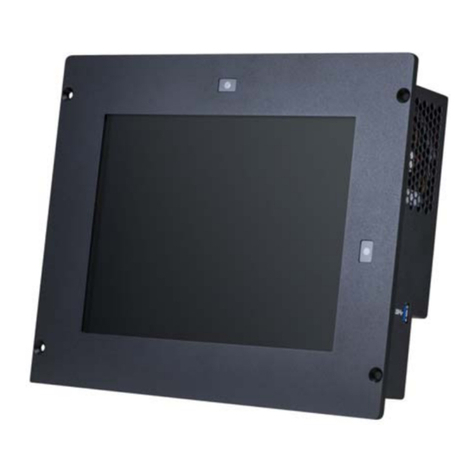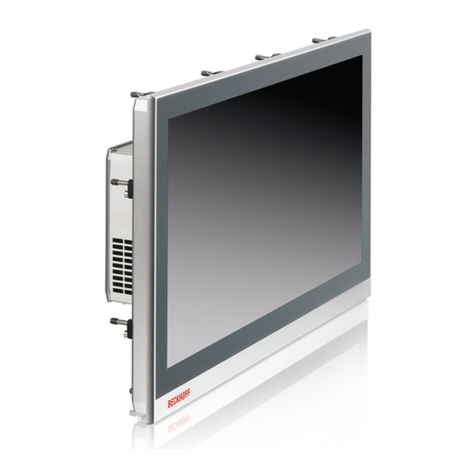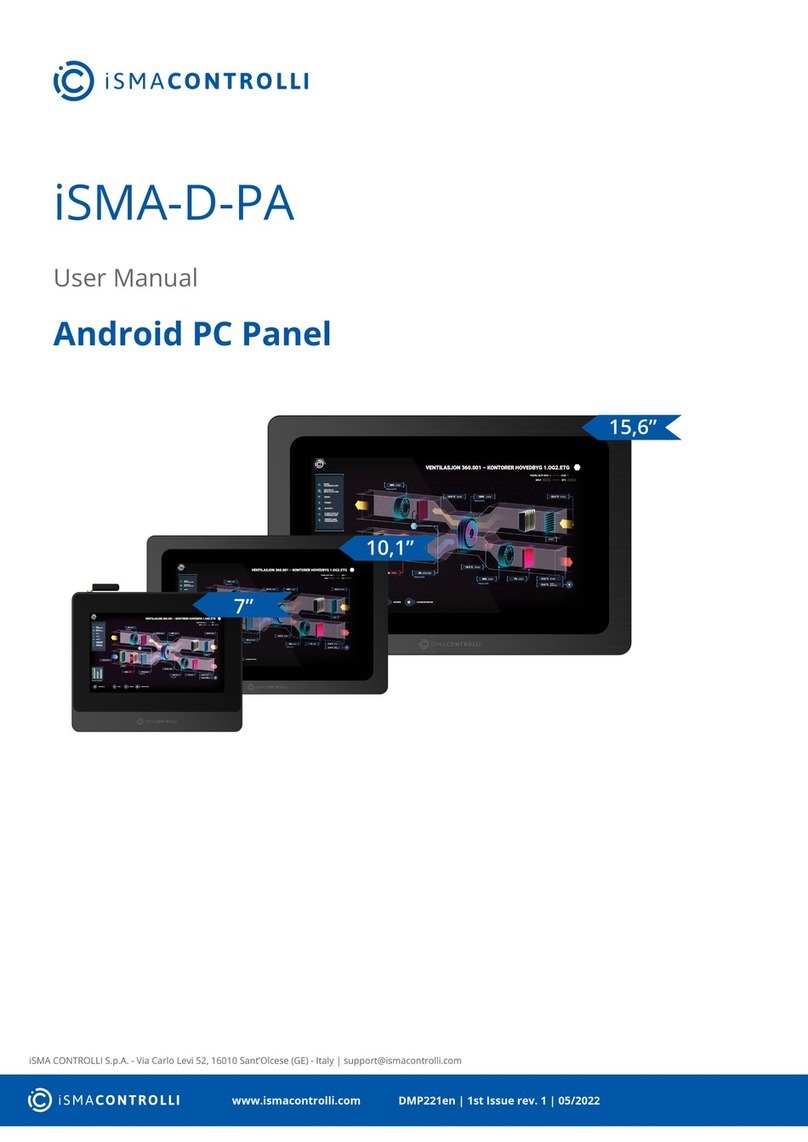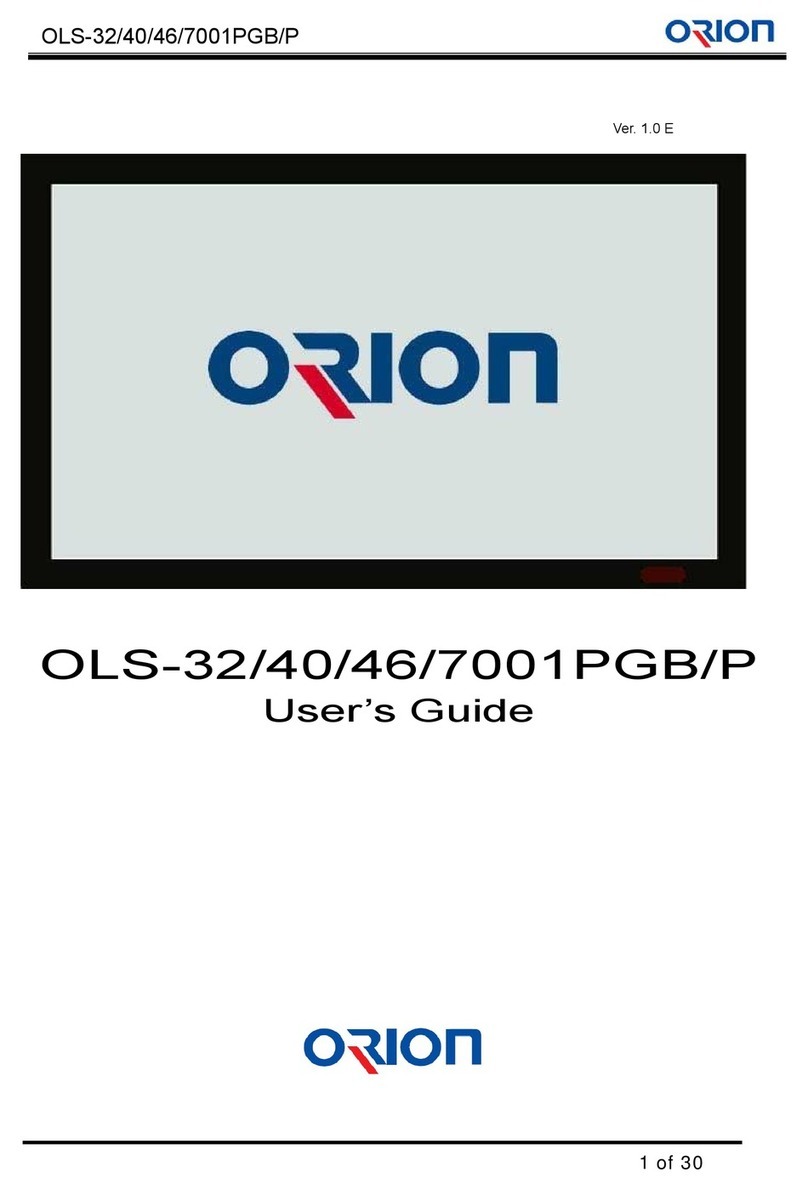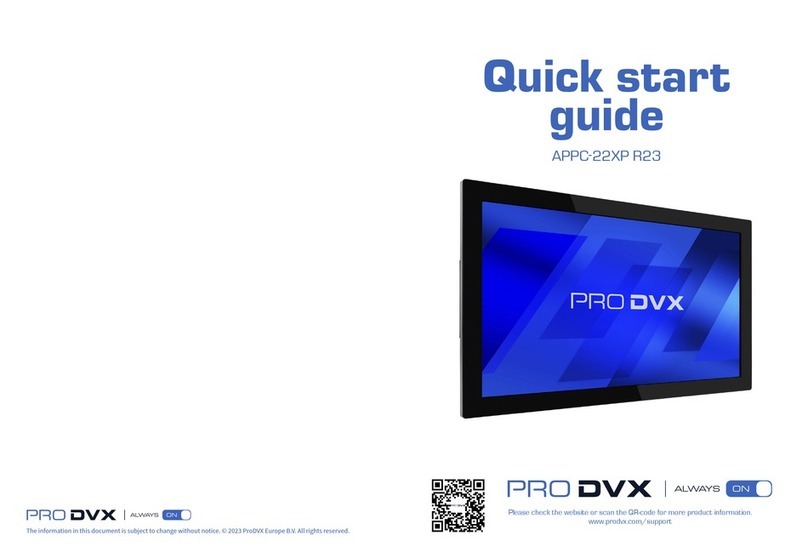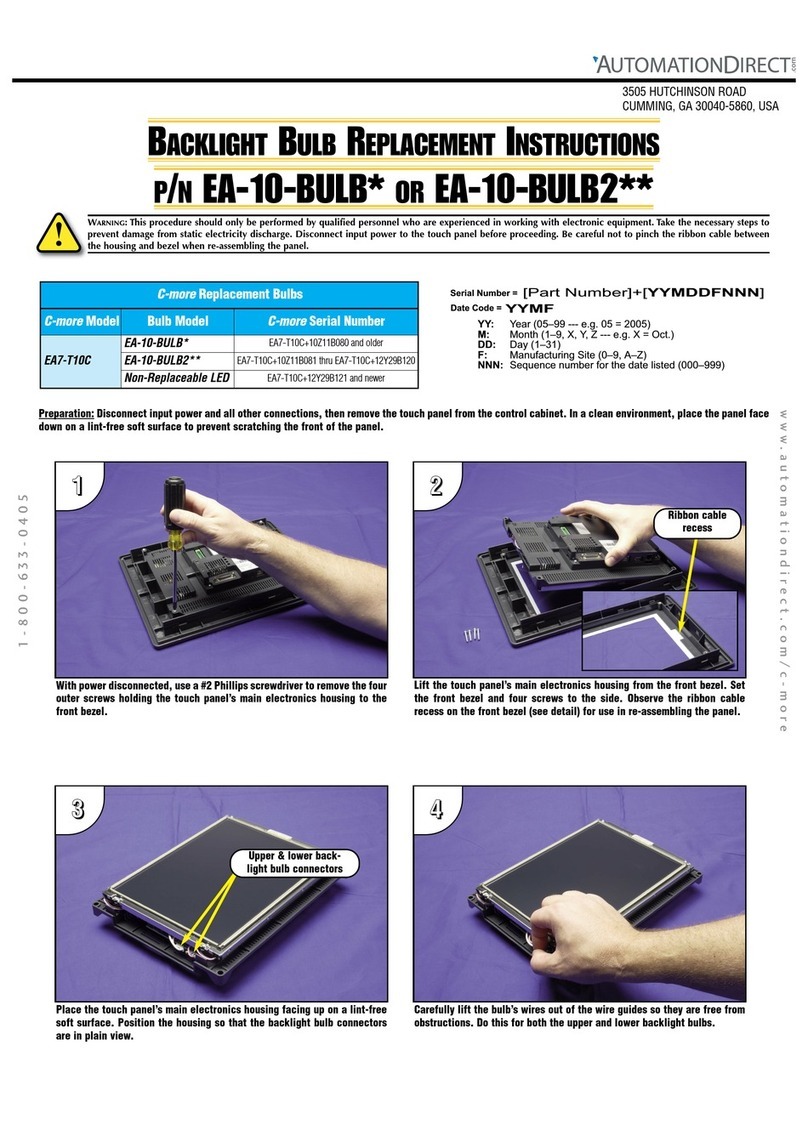Switzer 105 Instruction Manual

1
OPERATION & MAINTENANCE INSTRUCTIONS
DIFFERENTIAL PRESSURE INDICATOR — 105 / 106
A DESCRIPTION
The models 105 & 106 are all-metal Differential Pressure Gauges capable of operating at low differential pressures that
is suitable for full service applications in high pressure systems. The gauge has a multiple stack diaphragm capsule (in
model 105) or a single bellows (in model 106) sensor and a torque tube motion output. The sensor carries a direct
acting equalizing valve that fully protects it from over pressure in either the high to low or the low to high direction up
to the full static working pressure of the system.
The compact integral design of the models 105 & 106 results in a simple, basic design that is reduced to essential and
necessary elements with a high output motion and rugged construction.
DETAILS OF CONSTRUCTION
The sensor assembly is mounted between two pressure housings. One housing is the high side pressure inlet, the
second is the low side pressure inlet. The motion of the sensor rotates a hermetically sealed torque tube that operates
an output shaft that drives an external indicator and switch (es), when specified.
The indicating mechanism of the models 105 & 106 Differential Pressure Gauges is contained in a weatherproof dial
housing, that is solidly bolted and sealed to the differential pressure sensor unit. The output shaft from the sensor
bellows projects into the dial housing. The shaft is linked to a sensitive jewelled pointer movement through a lever
arm on the shaft. The linkage is a light small diameter polished wire which results in low friction and a self aligning
feature. The pointer movement is a standard pattern low-ratio gear movement with jewelled bearings on the pinion and
segment shafts. It can be easily adjusted for calibration of span and linearity. The input shaft lever arm is also
adjustable for linearity.The cover lens seals against a cushioned gasket in the dial housing.
SPECIAL FEATURE
The sensor is provided with an Over Pressure reliefValve (OPV). When the Differential pressure exceeds 130 % of the
range the OPV opens up and equalises the pressure between High pressure & Low pressure. similarly when low pressure
exceeds the sensor rating the OPV opens up and equalises the pressure between High pressure & Low pressure.
B SPECIFICATIONS
Model 105 Model 106
Pressure Housing Investment Casting Investment Casting
Sensing Element Multiple Diaphragm Capsule Seamless Bellows
Dial Size 6" Nominal 6" Nominal
Dial Pattern ( STD) Black letters on White Black letters on White
Dial Pattern (LLC) White letters on Black White letters on Black
Pointer Narrow Tip Narrow Tip
ZeroAdjust Dial Adjustment Dial Adjustment
Dial Housing Die Cast Aluminium ( Std.) Die CastAluminium (Std.)
304 SS (Optional) 304 SS (Optional)
Lens Shatter Proof Glass Shatter Proof Glass
Mounting Panel or 2" Pipe or Wall Panel or 2" Pipe or Wall
Proceess Ports 1/4" NPTF @ Top & Bottom 1/4" NPTF @ Top & Bottom
with one pair plugged with one pair plugged
Switching (LLC) Option Refer Catalogue Refer Catalogue

2
C OPERATING LIMITATIONS
Our Warranty of the Differential Pressure Unit will not apply if the following limitations are exceeded :
TEMPERATURE
(–) 60° F. to + 200° F
PRESSURE
Units are capable of line pressures up to the MWP ( printed on the dial ) without damage or permanent change in
calibration.
PULSATION
Rapid pressurisation can cause severe damage to the sensing element. Rapid pressure change (either increase or
decrease ) can be described as a change in pressure occurring fast enough to drive an instrument in less than a second.
If the DPI gauge is to be subjected to pulsation, make sure the externally adjustable pulsation dampener (Snubber) is
adjusted correctly to prevent damage to the instrument. All instruments are shipped with the Snubber trimm ¼ turn
open. Use a screwdriver to adjust this trimm until the proper dampening effect is obtained. Approximately 1½ turns
is fully open. The Snubbers are provided at both ports. Severe pulsation will affect the accuracy of the instrument
VIBRATION AND SHOCK
Do not subject instrument to severe mechanical vibration or hydraulic shock, unless the unit has been specially
ordered for such severe operating conditions.
D INCOMINGINSPECTION
UNPACKING
Check for shipping damage to cartons and contents. Check contents against shipping order, contents should include
(1) Material itemised on order and
(2) Installation instruction.
IMPORTANT: When called for on order, the gauge is pre-cleaned for special application and sealed in a clear
plastic bag. Check for special installation instructions before breaking the seal on the sealed bag.
E LOCATION
!Locate the gauge such that it is easily accessible from ground level.
!Select a reasonably vibration-free location where ambient temperature does not exceed operating temperature
limits.
!Do not locate the instrument near vents or bleed holes discharging corrosive vapors or gases.
!In Liquid Measurement locate the gauge below the primary element to permit entrapped air or gas to be vented
into the flow line.
!For Steam and Gas Measurement place the gauge above the flow line to facilitate condensate draining.
!The distance between the primary device and the gauge shall be as short as possible. For distances up to 50 feet
use 1/4" or 3/8" pipe or tubing. For runs 50 to 100 feet use 1/2" pipe or tubing. Distances exceeding 100 feet are
not recommended. The recommended distance limitation does not apply if an air-purge system is used.
G MOUNTING
The Instrument is adapted for mounting as :
(a) Panel Mounting
(b) Pipe Mounting for 2" Pipe on stanchion or Wall.
The instrument is supplied with a mounting bracket suitable for both wall & 2" Pipe mounting.
The instrument must be approximately level for proper operation.
Since SwitchingType Instruments work on very sensitive optical sensing it is recommended that the instrument is
mounted such that direct sunlight or direct light source do not impinge on the front of dial. Preferable to provide
a canopy.

3
FLUSH OR PANEL MOUNTING
Remove the gauge cover and provide a hole in the
panel as per the mounting dimensions. Mount the
gauge with the foue M5 mounting studs & nuts. Orient
the axes of the dial for readability and appearance and
wrench tighten the retaining nuts. Replace the gauge
cover.Torque screws evenly to avoid overstressing lens
window on the gauge.
WALL MOUNTING
Drill four mounting holes on wall to match the 71.5 mm
pitched mounting holes of the bracket. Secure
instrument with bolts and nuts.
PIPE MOUNTING
Mount the instrument onto a 2" Pipe using the pair of “ U ” bolts & nuts and secure the instrument & orient the gauge
as required and tighten the bolts firmly. Ensure rigidity.
CAUTION : Do not orient by turning or grasping the indicator case.
H CERTAIN PRACTICES SHOULD BE FOLLOWED ONALL FLOWAND LIQUID LEVEL D.P GAUGE PIPING
"Make up all joints using a suitable pipe joint compound to reduce measurement errors caused by leaks in the pipe
joints.
"Slope all piping at least 1 inch per linear foot to avoid liquid or gas entrapment.
"If process media exceeding 200° F (93°C ) is to be measured, provide 2 feet of un-insulated piping between the
primary device and the D.P Gauge for each 100° F (37.8°C ) in excess of 200° F.
"Install a valve manifold connecting the D.P Gauge and the differential pressure source to facilitate operation and
checking of the D.P Gauge. Locate shutoff and bypass valves to be readily accessible to the operator from the
front of the instrument.. The shutoff valve should be the first valve from the process line or vessel.
"D.P Gauge have two pairs of 1/4" NPT pressure connections.
I INSTRUMENT START UP
IMPORTANT : Prior to placing the instrument in service, perform the following operations
#Since the bellows may have taken a slight “set” due to possible extended periods of storage prior to installation,
it is advised that the first time the D.P Gauge is used and prior to actual operation, the unit be exercised to ensure
correct indications. To exercise the unit, sequentially apply maximum and minimum differential pressure to the
high pressure side for at least ten cycles.
#Open up the Front Bezel and the Dial Lens and remove the sponge placed beneath the pointer. Pressurisation
without removal will lead to Pointer shift from its original position.
#Although the D.P.Gauge is a seamless Rupture-proof bellows type instrument, care should be taken not to
subject the instrument to unnecessary shock or over range pressure during startup .Connect a Three valve manifold
Block . Make sure block and bypass valves are closed when beginning start-up procedures.
#Check manifold and piping for leakage by opening the block valves, one shutoff valve and the bypass valve to
pressurize the instrument. Then close the shutoff valve and by pass valve to pressurize the instrument. If pointer
travels upscale, then it indicates leak in low pressure piping; & if pointer travels downscale, then it indicates leak
in high pressure piping.
#Zero check the instrument. To do this, close the block valves and open the bypass valve. This equalises the
pressure on both sides of the instrument. If the instrument does not indicate zero, set pointer to zero by rotating
Dial by loosening the zero Adjust Screw on the Dial & re-tighten it after Zero adjustment.
#TOCHECK CALIBRATION
First zero the instrument at atmospheric pressure & connect a calibration instrument such as Swiscal Digital
Portable Manometer to the high pressure connection of the Gauge. The low pressure connection is vented to
atmosphere.With the help of an aspirator bulb or regulated air source apply increasing pressures of 20, 50, 80 and
FLUSH PANEL MOUNTING
BACK VIEW PANEL CUTOUT MOUNTING DETAIL

4
100 percent, of full-scale differential to the HP housing. Exercise care to always approach the desired scale
reading from the low D/P side; if you overshoot and drop back to the reading, your calibration will be incorrect.
Repeat the procedure, by reducing pressure and stopping at the same scale readings, now taking care to always
approach readings from the high D/P side. Compare D.P Gauge readings with the Master Gauge.
Inconsistent readings may be the result of the pointer dragging against the scale plate. To inspect for this
condition, remove the lens. The end of the pointer should be no closer to the scale plate than 1/32 inch throughout
its arc of travel. If necessary, bend the pointer away from the scale by gently pulling on the outer end.
If indications are within specified tolerances, no further calibration is required.
If instrument readings are outside specified tolerances, re-calibration is required. Send the instrument to factory.
#To Set the SwitchActuation
The Switch setting are to be done after opening up the bezel. With a screw driver adjust the positioning of the set
pointer in the arrow direction marked up on the dial. Before commissioning check up the functioning of the
switching action during the calibration check explained above.
After instrument has been checked to read correctly, replace lid and/or glass assembly.
J INSTRUMENT INSTALLATION RECOMMENDATIONS
♦Rapid pressurization can cause severe damage, to the sensing element, in all types of pressure instruments.
Modest quality instruments (± 2 to 5% full scale accuracy) are usually unaffected by this type abuse because of
their relatively simple design. More sophisticated instruments (± 1 % full scale accuracy, or better) are quite
likely to be damaged by rapid pressurization or over range.
♦Most better quality instruments have an over range protection mechanism built into them, but since they are
mechanical in design, they cannot be relied on to react in time to protect the instrument against such a rapid
change in pressure. (This is one reason rupture disks, in addition to pressure relief valves, are required on some
pressure vessels.
♦As explained earlier the simplest method of avoiding this problem (for differential pressure instruments) is by
installation, and proper use of, a three valve manifold . Opening the equaliser valve, prior to opening one or both
of the block valves, will tend to insure that pressure is applied simultaneously to both sides of the sensing
element.In addittion to this arrangement the snubbers supplied along with the instrument offers a back up protection.
♦As a general practice wherever possible, instruments should be located at a higher elevation than the process connections
on the equipment, or process device, on which they are being installed. Frequently, when trouble is encountered, it is
found that the instrument has been installed at an elevation below the process connections, allowing particulate matter
to flow by gravity into the instruments, resulting in erratic performance or complete malfunction. If for viewing
properties, or other reasons, the above recommended location is impractical, there is an alternative procedure. Provide
either a “pigtail” loop, or a “dropleg” (U–tube manometer configuration) in the tubing between the instrument and the
process connections. Since most instruments do not have flow through them, such an installation practice will insure
that solids will not be moved, by gravitational force, into the instrument.
However a more detailed line up procedures for typical & special installations are presented in Figures 2
through 14.
Use the diagram most applicable for specific requirement as a guide.
TYPICAL SCHEMATIC ARRANGEMENT FOR CALIBRATION OF D.P. GAUGES

5
FOR STEAM SERVICE (FIG.2)
START UP
Recommended when Instrument located above primary element
and where self draining is possible& for operating temperature
upto 200°F
1. Whatever the location of the meter body, make all primary element
taps at or near top of pipe
2. Close block valves & vent valves (if used). Open bypass valve
and shut-off valves.
3. Slowly and simultaneously open block valves, then close shut-off
valves.
4. Slowly and simultaneously open shut-off valves.
5. Close bypass valve for D/P reading.
If D.P.Gauge to be located below the primary element, see fig 3.
For higher temperatures, see Fig. 4.
FOR STEAM SERVICE (FIG.3)
START-UP
Reccomended when Instrument located below primary element
and for operating temperature upto 200°F
NOTE
To prevent overheating during instrument blow-down, monitor the
temperature by placing your hand on the pipe between the D.P.gauge
and the vent valves.
1. Close shut-off valves and vent valves (if used). Open by pass
valve and block valves.
2. Remove side and fill plugs from condensate chambers.
3. Fill piping and instrument chambers with water by pouring into
fill port in both condensate chambers to the level of the side
plugs.Instrument chambers and piping must be free of bubbles.
When instrument and piping are completely full, pointer will
rest at zero.
4. Install plugs in ports of condensate chambers.
5. Slowly and simultaneously open shut-off valves then close.
6. Check for leaks as explained in clause I.
7. Slowly and simultaneously open shut-off valves.
8. Close bypass valve for D/P reading.
FOR STEAM or HOT GASES (FIG.4)
START-UP
Recommended when Instrument located above primary element
and for operating temperature greater than 200°F.
See clause “ H ” and then follow steps in Fig.3.
K D.P.GAUGE PIPINGDIAGRAMS

6
FOR GAS SERVICE (FIG.5)
START-UP
Recommended when Instrument located above primary element
and where self draining is possible NOT recommended when
hydrates are present
1. Whatever the location of the meter body, make all primary element
taps at or near the top of the pipe.
2. Open manifold valves and bypass valve, open one block valve
and one shutoff valve to pressurise instrument.
3. Then close block valve and bypass valve .
4. Check for leaks as explained in clause I.
5. Open bypass valve, open block valves and slowly open both
shutoff valves simultaneously.
6. Close bypass valve for D/P reading.
If hydrates are present, or the instrument to be located below the
primary element, see fig.6.
FOR GAS SERVICE (FIG.6)
START-UP
Recommended when hydrates or heavy solids are present. Piping
diameter not less than ½". Drain valves are required
1. through 5. Follow steps in Fig. 5.
7. Drain condensate chambers of hydrates at regular intervals.
CORROSIVE FLUIDS (FIG.7)
START-UP
Recommended when the flowing medium is highly corrosive,
contains solids in suspension, is highly volatile, Or for some other
reason would damage the instrument. Use 109 Model with liquid
or chemical seals to prevent the medium entering the instrument.
LOCATION FOR SEALS
Place as close as possible to the primary element to reduce the length
of piping filled with process fluid.
On high temperature applications, locate the seal at least 36" from
the primary element shutoff valves to prevent overheating.
NOTE : When measuring liquids, locate pressure taps at or near
BOTTOM of pipe. Diaphragm type Seals can be used in place of
condensate Chambers (eliminate steps 2 through 6).
1. Close shutoff valves; open manifold valves and block valves.
2. Remove fill and side plugs from seal pots.
3. Fill seal pots, piping and meter housings with the immiscible
seal fluid by pouring into upper fill ports.Instrument housings,
tubing and seal ports must be filled to seal pot side ports with
bubble-free liquid. Pointer will indicate zero when both high
and low pressure chambers are filled equally.
4. Install side plugs and close all valves.
5. Slowly open each shutoff valve alternately until fill port (skip
this step in gas application)
6. Replace fill plugs.
7. Check for leaks as explained in clause I.
8. Open manifold valves and block valves, then SLOWLY open
both shutoff valves simultaneously.
9. Close bypass valve for D/P reading.

7
FOR LIQUID SERVICE (FIG.8)
START-UP
Recommended when the flowing medium volatile or gassy liquids.
Make all primary element taps at or near bottom pipe.
CAUTION:Maximum operatingtemperature permissable 200°F(93°C).
For higher temperature media, follow as explained in clause H. With
hot or gassy fluids, disconnect instrument and fill both Housings and
piping though manifold with process fluid cooled to below 200°F, then
reconnect. Open block valves, bypass valve, and one shutoff valve.
1. Alternately crack drain vales (connected to lower instrument
body ports) until liquid, free of bubbles, spills out both ports.
2. Close both drain valves and shutoff valve.
3. Pointer should indicate zero. If not, and no leaks are detected,
the housings and/or piping are not completely full of bubble-
free liquid. Repeat steps 1 through 4 until pointer remains
stationary at zero.
4. Open both shutoff valves, close bypass valve for D/P reading.
FOR LIQUID SERVICE (FIG.9)
START-UP
Recommended for use when sediments are present or when meter
cannot be mounted below line. Where sediments are NOT present,
make primary element taps at or near bottom of pipe. Periodically
inspect and clean instrument lines.
NOTE :Where process fluid is gasy or system is subject to numerous
no- flow conditions and instrument cannot be mounted below line,
install automatic air bleed fittings in top meter body parts or at high
point of instrument lines.
1. Open both block valves, bypass valve and one shutoff valve.
2. Alternately crack vent valves or loosen plugs from top ports of
instrument body housings until liquid, free of bubbles, spills out
of both upper meter body ports.
3. Close vent valves or replace plugs and close shutoff valve.
4. Pointer should indicate zero. If not, and no leaks are detected,
the housings and/or piping are not completely full of bubble-
free liquid. Repeat steps 1 through 4 until pointer remains
stationary at zero.
5. Open both shutoff valves, close bypass valve for D/P reading.
FOR COOL LIQUID SERVICE (FIG.10)
START-UP
Recommended for use with water, oil, or other media which will
not condense in low pressure piping.
For hot (volatile) liquids, see Fig.11.
Mount instrument centerline level with lower tank reading point. If
instrument is mounted below lower tank reading point, install a
reference leg per Fig.9, a bubbler system per Fig.12, an aspirator bulb.
NOTE : Do not share fill or vapour return lines with instrument piping.
1. Close all valves; open high pressure block valve and crack high
pressure vent valve
2. Slowly open bottom (high pressure) shut-off valve. When bubble
free liquid spills from high pressure vent valve, close vent valve.
Open low pressure block valve slowly open top (low pressure)
Shutoff valve. Crack low pressure drain valve to drain any
condensation and reclose.

8
FORCOOL orHOTLIQUIDSERVICE
START-UP
Recommendedfor useto cancelout the“dead leg” (piping from tank
bottom to centerline of meter body) when meter is mounted below
tank. Process medium can be used as reference leg seal fluid if it will
condense in the leg under all conditions. Otherwise, a non-miscible
sealfluid mustbe used.
CAUTION : If bypass valve is opened at any time when the tank liquid
level is below maximum, the reference leg must again be filled.
NOTE : Do not share fill or vapour return lines with instrument piping.
FORCOOLLIQUIDSERVICE(FIG.11)
1. Partially fill reference leg by opening bottom shutoff valve, both
block valves and bypass valve.
2. Crack vent valves on meter body housings; close when clear, bubble-
free liquid flows out.
3. Close bypass and block valve on reference leg.
4. Remove plug from side port in 2inch pipe cross connection used for
reference level reservoir, and fill the leg by opening block valve and
cracking the bypass valve until bubble-free liquid spills out.
5. Close bypass valve.
6. Replace plug in cross
7. Slowly open upper shutoff valve.
HOT(VOLATILE)LIQUIDS(FIG.11)
CAUTION :Maximummeter operating temperature is 200°F. See clause
H before proceeding.
1. Close shutoff valves; open both block valves, vent valves, and by
pass valve.
2. Remove plug from top port in 2" pipe cross. Use process liquid
(cooled to below 200°F) or other suitable seal fluid, and fill both
high and low pressure housings through cross until it runs out vent
valves bubble free.
3. Close HP vent valve and bypass valve. Fill reference leg and replace
Plug.
4. Crack LP (bottom) shutoff valve until fluid flows bubble-free from
LP vent, and re close.AVOID danger of scalding from hot liquid.
5. Slowly open both shutoff valves.
FORCOOL(NON-VOLATILE) LIQUIDSERVICE(FIG.12)
START-UP
NOTE : Do not share fill or vapour return lines with instrument piping.
SPECIFIC GRAVITY : For use to determine specific gravity changes
in a process medium.
1. Set bubbler input gas regulator at a pressure slightly higher than
process vessel pressure.
2. Open shutoff valves and block valves. Close bypass valve.
3. Adjust sight bubblers for equal gas flow to each tube, approximately
one bubble per second. Continous bubbling is necessary.
FORLIQUIDLEVEL
Recommendedforuse wheneversolidsorsludge arepresent,or when
instrumentmust be mountedabove tankbottom.
1. Delete LP sight flow bubbler (B)
2. On a pressurised tank, line up the LP port directly to upper tank
connection. On a vented tank, vent the LP port to atmosphere.
3. Follow steps 1 through 3 under “Specific Gravity”.

9
FOR LIQUID GASES SERVICE (FIG.13)
START-UP
Recommendedfor use withCO, Butane, Propane,Freon, and other
liquified gases warmer than–150°F (–101°C). Meter may be
mounted above or below tank.
Vapour generator is a 12" length of 1" to 1½" diameter pipe; avoid
traps or pockets between vapour generator and tank. Install inverted
“U” gas trap inside tank. Do not insulate piping below lower shutoff
valve. Do not share fill or vapor return lines with meter piping.
1. Close block valves.
2. Open drain valve and loosen meter housing drain plugs to remove
all liquid from system. Replace plugs.
3. Close drain valve and slowly open bottom shutoff valve to allow
liquid to enter gas generator.
4. Open upper shutoff valve and block valves.
FOR CRYOGENIC LIQUID SERVICE (FIG.14)
START-UP
Recommended for use with Oxygen, Nitrogen, and Agron.
Instrument may be mounted above or below tank. Vapour
generator is a spiral of 3/8" turbing. Install an inverted “U” gas
trap inside tank. Do not share fill and vapour return lines with
meter piping.
CAUTION : Instrument designed for use with Oxygen are specially
cleaned and packaged, and MUST be kept clean. No organic
compounds, oil, grease, dirt, or scale of any kind can be tolerated in
an oxygen installation.
1. Close block valves. Loosen instrument body drain plugs to
remove all liquid from system. Replace Plugs.
2. Slowly open HP (bottom) shutoff valve to allow liquid to flow
through gas generator.
3. Open LP (top) shutoff valve, and open block valves.
L FINALADJUSTMENT
It is advisable to recheck instrument zero and to test the operation of the bypass valve after the D.P. Gauge has been
placed inservice and fully subjected to differential pressure, line pressure, and process/ambient temperature.
CAUTION : Never zero check when only one block valve is shut. In gas flow service, a standing wave effect in the
process line can displace the indicator; the displacement could be assumed to be an erroneous reading.
1. With the instrument subjected to differential pressure and in service, observe the position of the pointer on the
scale and use this reading as a reference for checking the effectiveness of the bypass valve on the instrument
piping manifold. Close the H.P block valve. (Note that when checking instrument zero where seal pots are involved,
the primary element shutoff valve is used instead of the meter body valve on the piping manifold). If the pointer
moves from the reference position towards zero, it indicates that the bypass valve on the piping manifold is leaking and
must be replaced. If the pointer remains in the reference position, the bypass valve is functioning properly.
2. Open the bypass valve on the instrument piping manifold. The pointer should go to zero on the scale. If the
instrument does not indicate zero, check for gas or liquid entrapment in the lines or in the D.P. Gauge (depending
on the orientation of the piping layout and service). If necessary, adjust the pointer by turning the dial to bring the
pointer to zero reference.
3. Adjustment of the Pulsation Dampener
CAUTION : Never try to remove the pulsation dampener adjusting screw. Serious injury can result if adjustment screw
is removed with the instrument under pressure. When an increase in dampening is required, as indicated by a quivering
movement of the instrument pointer, turn the damping screw clockwise until the pointer just stops its oscillation. Do
not over-adjust. (See “Operating Limitations-Pulsation” explained earlier). Further damping will decrease the speed
of response and introduce unnecessary time lag into the measuring system. Recheck instrument zero.

10
M TROUBLESHOOTING
If trouble occurs, it is recommended that the routine shown below in tabular form be followed :
ELBUORTECRUOSELBISSOPNOITCNUFLAMYDEMER
oNrowoL noitacidnI
rotnemelEyramirP erusserPlaitnereffiD ecruoS
.ezisrevoro,sdrawkcabdellatsniecifirO
.nurmorfmaertspudekcolbwolF
.)leveldiuqil(gelecnerefernidiuqilfossoL
romuidemssecorpnisegnahcytisneD .gelecnerefeR
.ylreporpllatsniro,ecifiroecalpeR
.evlavneporonurtuonaelC
.gelecnereferllifeR
emasfodiuqilhtiwgelecnereferllifeR .muidemssecorpsaytisned
yramirPmorfgnipiP .tnemelE .deggulpgnipiproselohpaterusserP
.gnikaelronepoevlavssapyB
.gnipipnideppartsesagrosdiuqiL
.desolcsevlavffotuhsrokcolB
.ediserusserphgih,skaelgnipiP
.gnipiptuonaelC
)s(evlavssapybesolC
.gnipiPtneVecalpeR
.sevlavffotuhsrokcolbnepO
.skaelriapeR
tinUswolleBsdiloshtiwpudellifsgnisuohdnE .tnemevomswollebgnitcirtser
roecivresdiuqilnignisuohnideppartsaG .ecivressagnignisuohnideppartdiuqiL
.skaelteksaggnisuoherusserphgiH
.htiwderepmattnemurtsnI
.sgnisuohtuonaelC
.gnisuohniardrotneV
.teksagecalpeR
.sriaperrofylbmessatinuswollebnruteR
msinahceMtnemevoM.tnemevomrosmraegaknilesooL
.noitarbilacfotuO
.msinahcemnitridronoisorroC
.esoolretnioP
.ecalperronethgiT
.etarbilaceR
.ecalperronaelC
ecalperronethgiT
hgiH noitacidnI
tnemelEyramirP yramirPmorfgnipiP tnemurtsnIottnemelE
.llamsootrodetcirtseryllaitrapecifirO
.gnipiperuserpwolnikaeL
.snoitacidnIlevelknatrofpu-koohtcerrocnI
.ecalperrotuonaelC
.riapeR
laniFdnasmargaiDgnipiPreteMeeS .tnemtsujdA
tinUswolleBnignisuoherusserpwolnideppartsaG hgihnideppartdiuqilroecivresdiuqiL .ecivressagnignisuoherusserp
.skaelteksaggnisuoherusserp-woL
.nekorbgnirpSegnaR
.htiwderepmattnemurtsnI
.gnisuohniardrotneV
.teksaGecalpeR
.gnirpSegnaRecalpeR
.sriaperrofylbmessatinuswollebnruteR
msinahceMtnemevoM.tnemevomrosmraegaknilesooL
.noitarbilaCfotuO
.ecalperroriapeR
.etarbilaceR
citarrE
noitacidnI
tnemelEyramirP yramirPmorfgnipiP tnemurtsnIottnemelE
.gnitaslupwolF
saGrognipipsagnideppartdiuqiL .gnipipdiuqilnielbbub
.dellatsniyltcerrocnirotarenegropaV
.gnisiruopaVdiuqilroyssaggelecnerefeR
.levartnodruobdetcurtsbO
.renepmadnoitasluptsujdA
)snoitcurtsniputratseeS(evomeR
.epipeR
.smargaiddnasnoitcurtsnignipipeeS
eeSnIdnanoitcepsnIydoBtnemurts
gninaelC.
tinUswolleB-wolroerusserp-hgihnideppartsaG .gnisuoherusserp
gnirpSegnaResooL
.)smargaiDgnipiPreteMeeS(evomeR
)segnahCegnaReeS(tsujdadnanethgiT
msinahceMtnemevoM.ytridrogniggardtnemevoM
.etalpelacsnogniggardretnioP
.naelcdnatusjdA
.tsujdA

11
N MAINTENANCE
Periodic inspection and cleaning of the D.P .Gauge is standard recommended practice. Recalibration, unless required
because of a defective component or workmanship, is also considered a normal maintenance function.
REMOVING THE INSTRUMENT FROM SERVICE
1. Close the H.P. primary element shutoff valve.
2. Open bypass vale in the line between the seals (where applicable)
3. Close the low pressure primary element shutoff valve.
4. Close the high pressure meter body shutoff valve on the piping manifold.
5. Open the bypass valve on the piping manifold.
INSTRUMENT INSPECTION & CLEANING
When instruments are used in services where solids or semi-solids can accumulate, the meter body housing and
bellows will require periodic inspection and cleaning. This can be performed as follow. Also refer the Assembly
breakdown Drawing.
1. Remove instrument from service,as described above.
2. Open up the Dial unit ,remove pointer using pointer puller, then the dial.
3. Carefully remove the link wire at the Torque Tube end without disturbing the movement.
4. Detach the Dial Housing slowly from the Sensor Housing unit without removing or disturbing the Torque Tube
output lever by slowly passing the Dial Housing over the Torque Tube through the hole in the housing.
5. Carefully and slowly remove High & Low housingsby removing the four M12 / M10 bolts.If accumulation of
process material is extensive, removing the housings too rapidly can damage bellows convolutions.
6. Carefully remove the Range Spring located on its I.D on the OPV Shim.
7. Do not disturb and remove the bellows from its position.
8. Rest the High Body on its bottom surface with the bellows upright.
9. With a blunt smooth rod 3 mm Øpush the rubber ball against the force of ball retainer spring located behind the
ball and then flush the OPV with water to clean up the accumulations inside it. If necessary use a suitable solvent
but compatible to the seal Material.
10. Similarly clean up both the High & Low Housings by flushing. Use a solvent, if possible, to remove the
accumulations.
11. After cleaning up, replace the Range spring by locating it on the OPV Shim.
12. Re-fix the Low Housing on to the High Housing without disturbing or damaging the bellows & tighten the four
bolts with sufficient torque of 80 lbs-in enough to prevent leaks. Ensure that High & Low Housing edges are
alligned at surface where the Dial Housing seats, and ‘O’Ring is in place.
13. Re-fix the Dial Housing back in position . Ensure that the gaskets are in position at the joint of Dial Housing and
the Bellows Unit and all the screws fixing it are tight or else will lead to failure of weather proofness.
14. Carefully ride the “V”of the Link wire into the hole of the bent portion of the Output lever attached to the
Torque tube.The linkage should be so positioned that the “V ”of the wire is free in the hole without creating any
friction at the point of rest.
15. It is also advisable to clean up the movement as well withAcetone to remove dirt and greasiness. Ensure effective
cleaning at gear teeth.


This manual suits for next models
1
Table of contents
Popular Touch Panel manuals by other brands
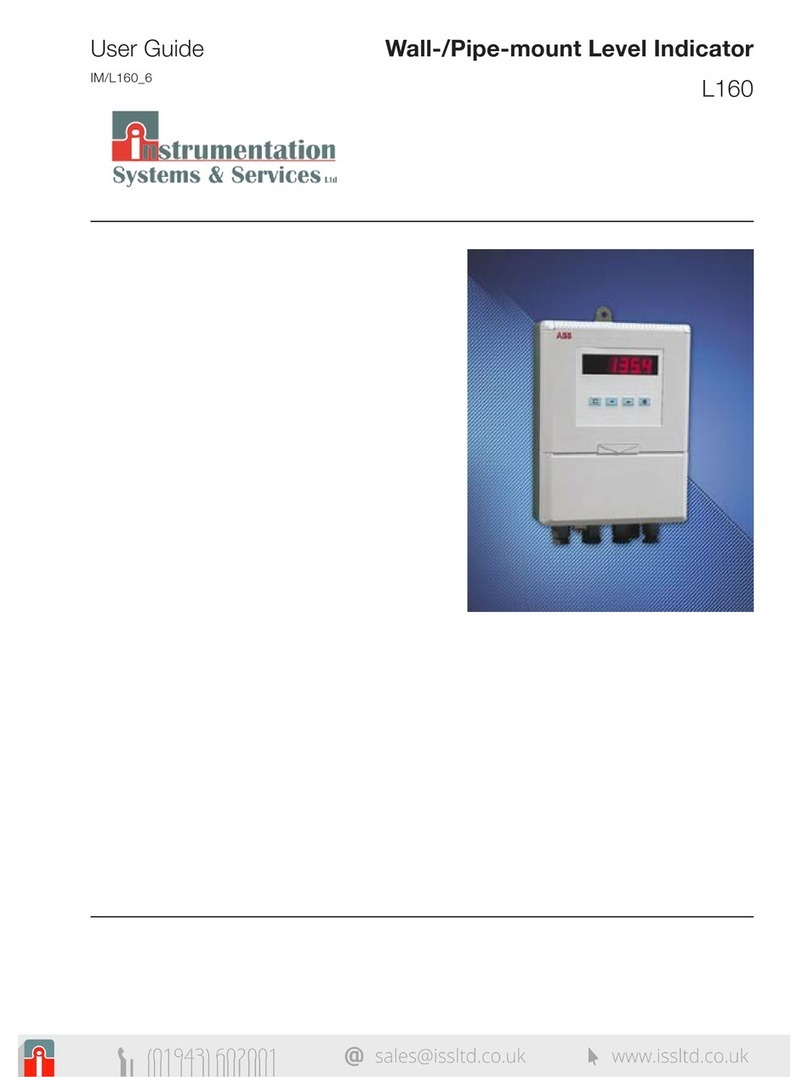
Instrumentation Systems & Services
Instrumentation Systems & Services L160 user guide
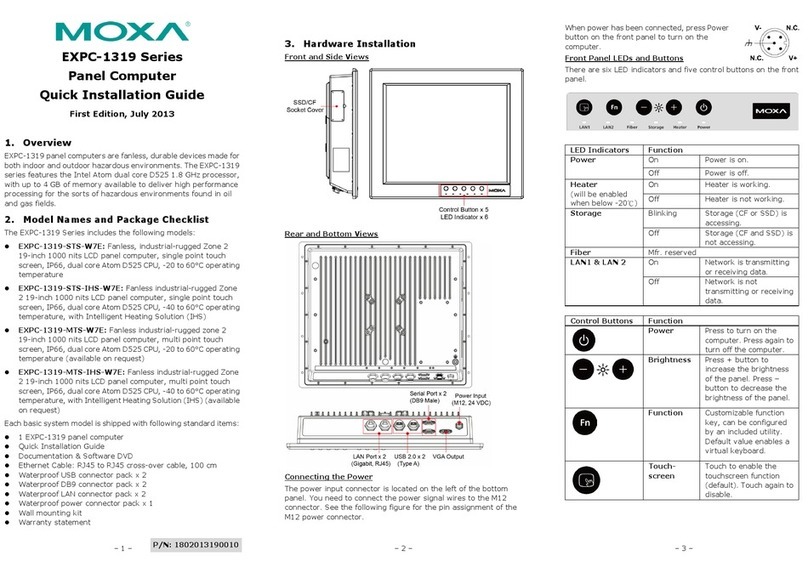
Moxa Technologies
Moxa Technologies EXPC-1319-STS-W7E Quick installation guide
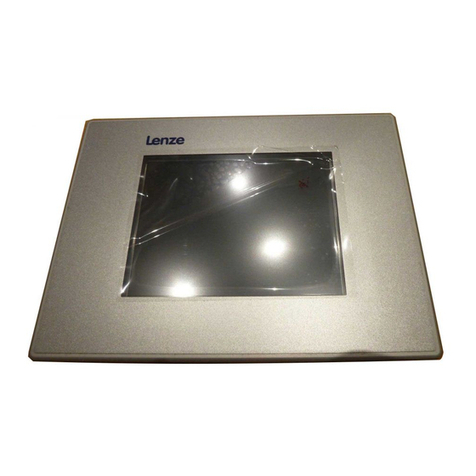
Lenze
Lenze EL 103 ECO PLC operating instructions

Rain Harvesting
Rain Harvesting Tank Gauge Installation and specification guide
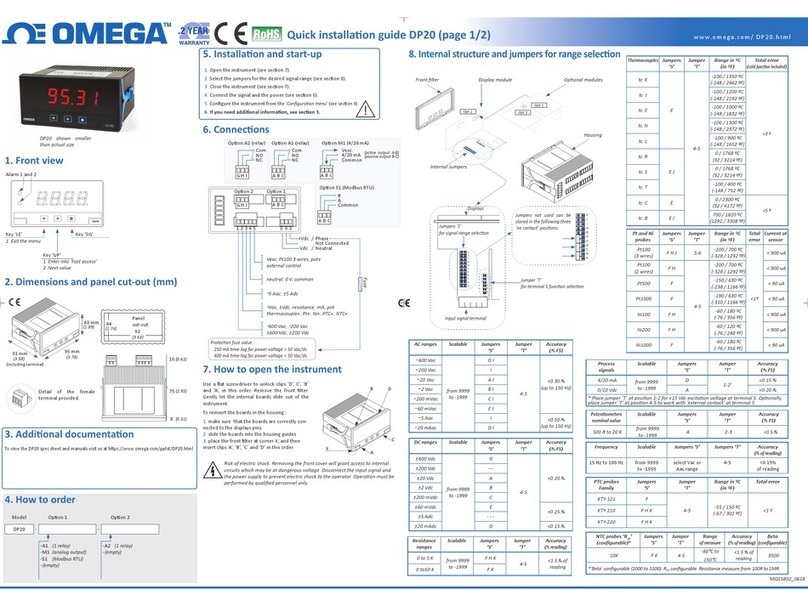
Omega
Omega DP20 Quick installation guide
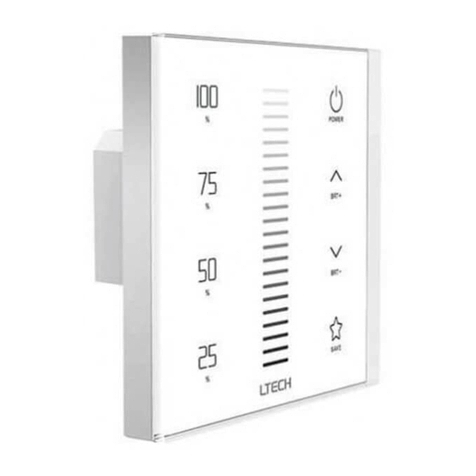
Ltech
Ltech E Series manual

